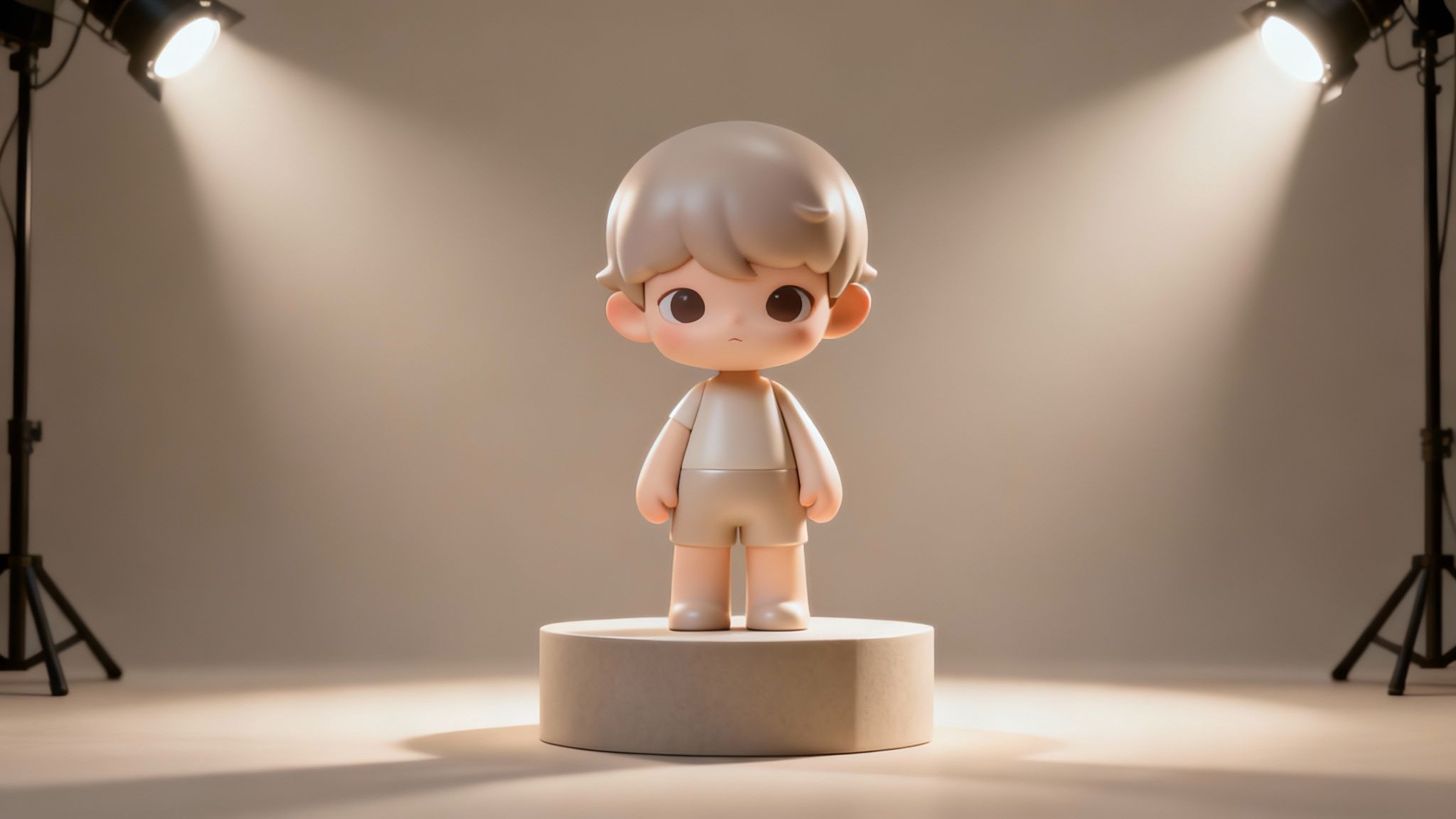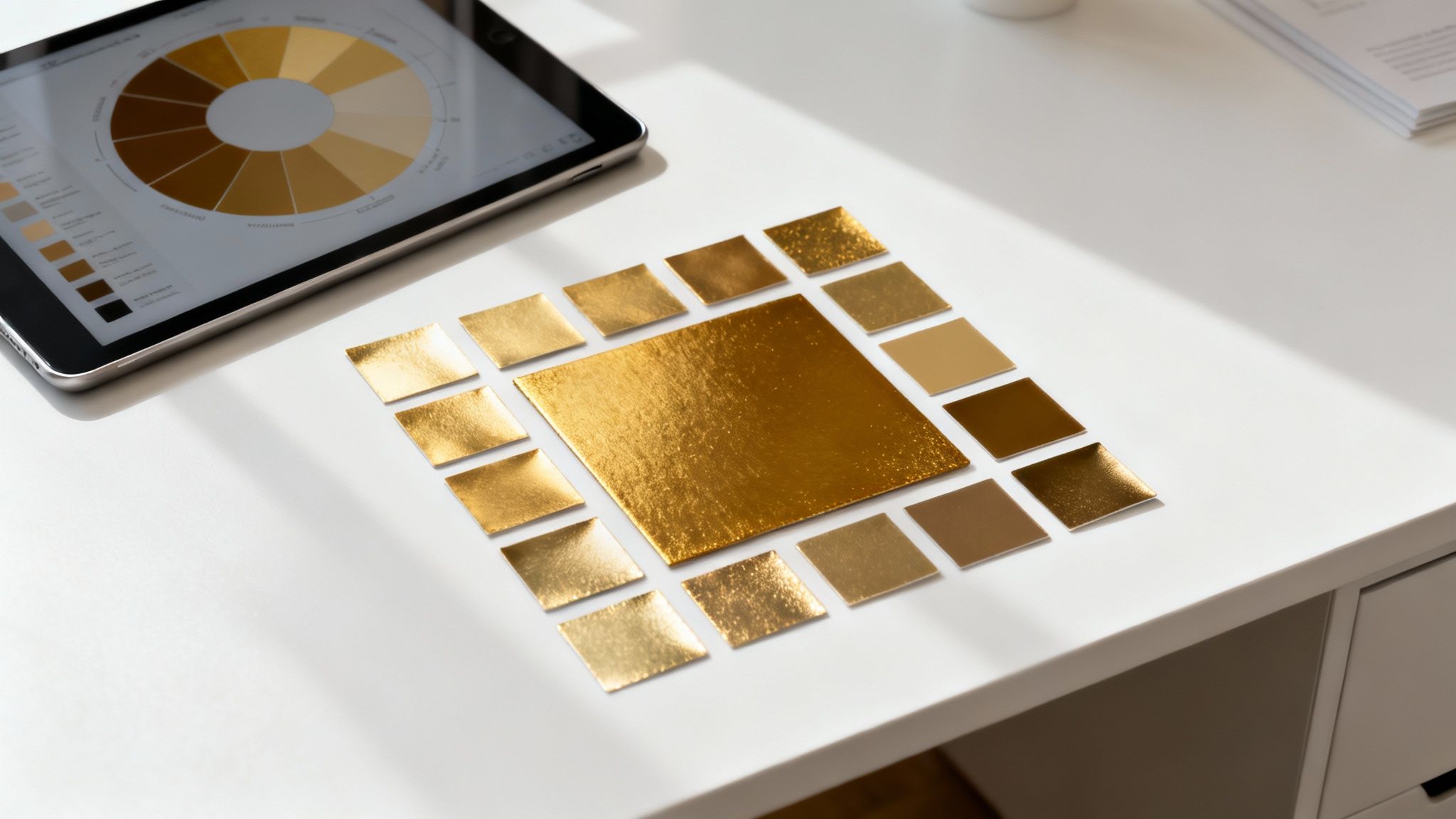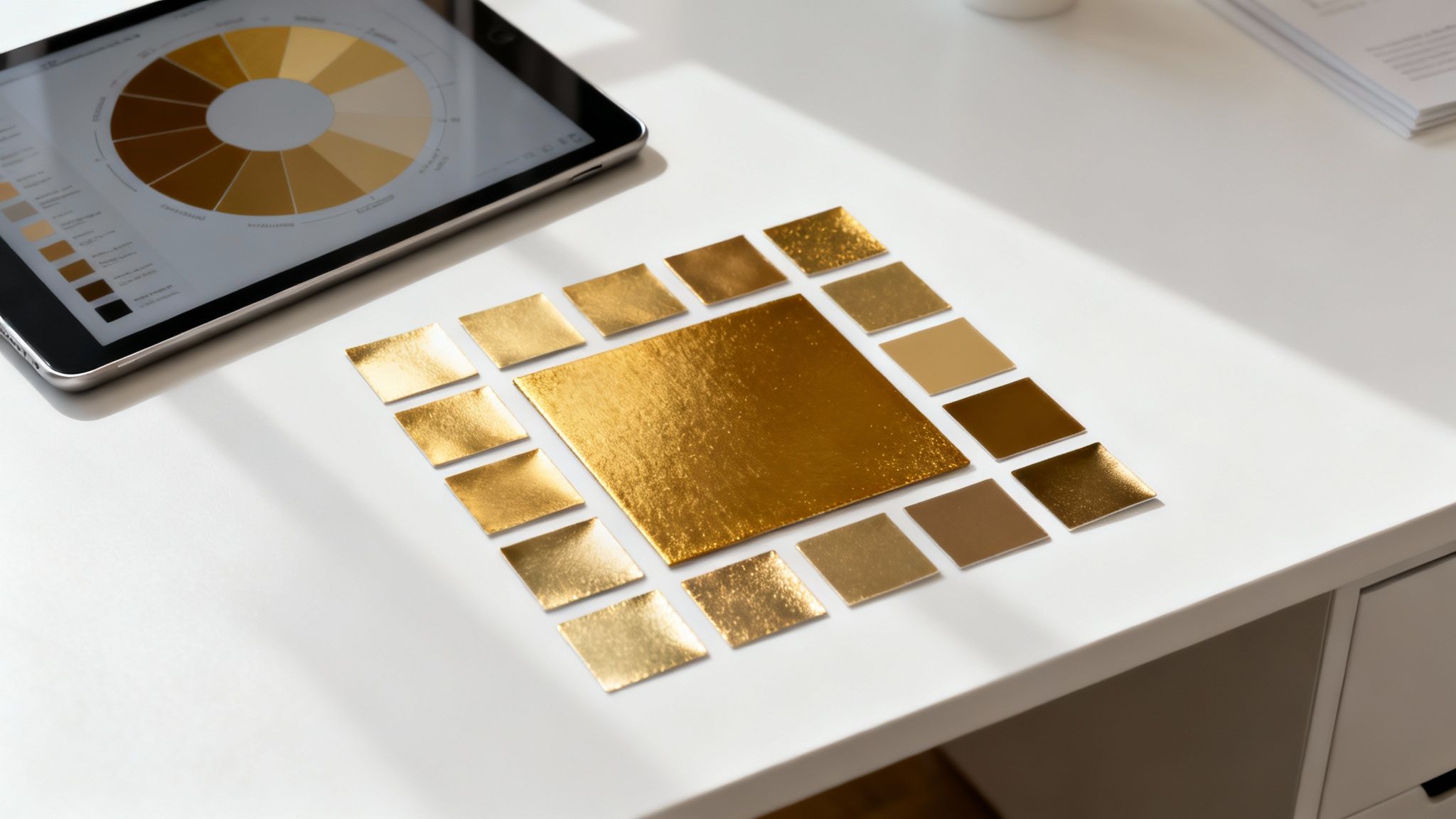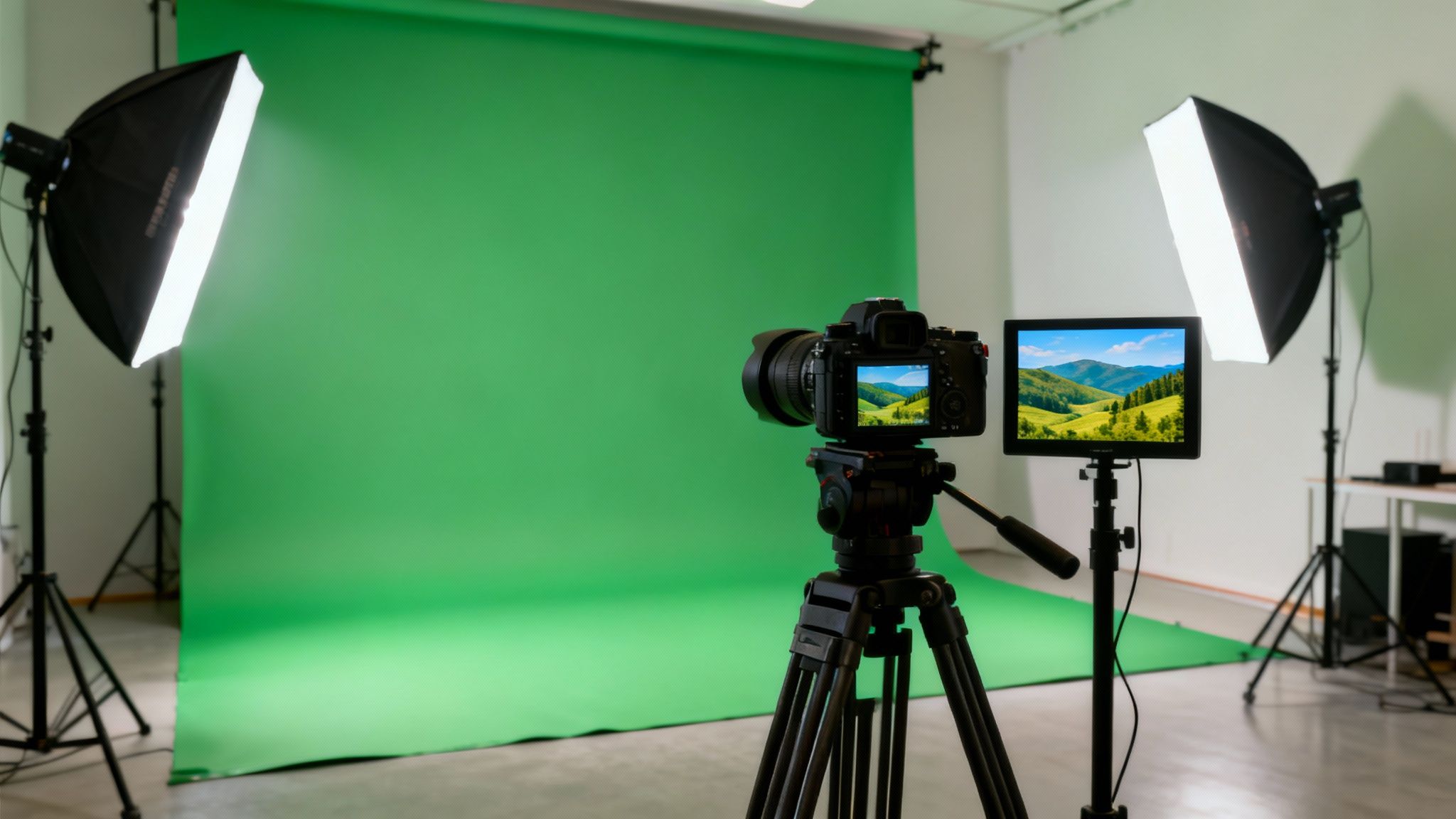Ever had an idea for a 3d cartoon character just pop into your head, only to get stuck on how to bring it to life? If you've been looking for a responsible and compliant way to integrate AI into your creative workflow, you're in the right place. Let's walk through the entire journey, taking that spark of an idea from a simple text prompt all the way to a 3D model that's ready to animate.
If you haven't generated anything already, you can start creating by trying the Virtuall Creative AI OS for free.
Your Path from Idea to Animation
Not so long ago, creating a 3D character was a massive technical hurdle. It was a world reserved for seasoned artists who were masters of specialised, complex software. That's all changing. AI tools have thrown the doors wide open, letting anyone with a vision create something incredible within a secure, enterprise-ready environment.
This guide is all about the practical steps inside Virtuall's Creative AI OS. We’ll skip the jargon and focus on what really matters: your creative idea. I'll show you how to brainstorm, refine your design, and generate an asset you can actually use for animation.
Think of the old animation pipeline—it was a long, winding road with dozens of distinct, time-consuming stages. Painstakingly modelling from a basic cube or sculpting every tiny detail by hand is now a thing of the past. You can let the AI do the heavy lifting.
The Modern AI-Powered Workflow
It all starts with your imagination. You just need to describe your idea in a prompt. An AI model takes that description and turns it into a 2D visual concept. From there, another AI tool converts that flat image into a foundational 3D model, which you can then clean up, texture, and get ready for animation.
This diagram breaks down how simple the process has become, moving from a text idea to a final 3D model.

As you can see, each stage builds on the last, turning a simple thought into a tangible asset with surprising efficiency.
This more accessible approach is making waves in creative industries everywhere. Just look at the 3D animation market in Denmark—it’s seen steady growth and is now valued at around $150 million annually. A huge slice of that comes from producing 3D cartoon characters for projects both at home and abroad.
The big idea here is to let AI handle the technical headaches. This frees you up to focus on the fun stuff—the character's personality, style, and story. It makes the whole process faster and way more intuitive than it’s ever been.
For a deeper dive into making your characters feel truly alive, check out these 10 hidden secrets to bring your 3D characters to life.
Alright, let's start building something.
Develop Your Character Concept with AI Prompts
Every memorable 3D cartoon character starts with a solid idea. This first phase is all about playing around, using AI text-to-image models to brainstorm and visualise different concepts without getting locked into one design too early. This is where your prompt engineering skills really shine.

Forget generic prompts like "cartoon character." The real magic happens when you get specific. Think of your prompt as a creative brief you're handing to the AI. The more detail you feed it, the more unique and compelling the results will be. Don't just describe what the character looks like; describe who they are.
This means defining their personality, key physical traits, and overall style right there in the text. You can churn out dozens of visual ideas in minutes, allowing for a rapid-fire iteration process that’s just not possible with traditional sketching.
Crafting the Perfect Character Prompt
Specificity is your best friend here. Adding descriptive keywords can dramatically shift the AI's output from something generic to a character that feels alive. And trust me, the small details matter. A lot.
Let's look at a couple of examples:
- Vague Prompt: "A cartoon knight"
- Detailed Prompt: "A clumsy but brave cartoon knight, stylized proportions with oversized gauntlets, dented helmet covering his eyes, cheerful grin, wearing a worn leather tunic, fantasy art style."
See the difference? The second prompt gives the AI so much more to work with. It hints at a backstory and a personality, which always leads to a more interesting visual. If you're looking to push your concepts even further, especially into motion, understanding how different models work is key. For instance, digging into mastering Sora 2 prompting can give you an edge for more dynamic ideation.
The goal is to move beyond simple descriptions and start telling a story with your words. A character with a "mischievous grin" will look fundamentally different from one with a "weary smile," and it’s these nuances that bring your creation to life.
Key Elements for Your Prompt
To make sure your prompts are hitting all the right notes, it helps to break them down into core components. A structured approach means you won't forget the little details that truly define your character.
I've found it useful to think in terms of a simple formula. The table below breaks down the key ingredients I use to build a strong character prompt.
Prompt Components for Character Design
By combining these elements, you’re essentially creating a powerful recipe for the AI to follow. This kind of structured thinking not only improves your results but also seriously speeds up the brainstorming process. It helps you zero in on the perfect look for your 3D cartoon character much, much faster.
Turn 2D Concepts into 3D Models
So, you’ve landed on a 2D concept that just feels right. The next challenge? Bringing it into the third dimension. This leap from a flat image to a tangible 3D model used to be a massive undertaking, but AI conversion tools have completely changed the game. Now, you can spin up a foundational 3D asset straight from your 2D design.

But it's not quite a one-click magic trick. Getting the best results starts with preparing your reference image. The AI needs a clear guide to understand the shapes and forms you’re envisioning. A clean, well-defined silhouette is your best friend here.
This new workflow is making waves globally. In Sweden, for example, 3D character production is a huge part of their animation industry, now worth over $500 million annually. Their studios have earned international praise for their iconic characters, which shows just how powerful efficient 3D creation can be.
Preparing Your Image for AI Conversion
A little prep work before you upload your image will save you a ton of headaches later. The main goal is to remove any guesswork for the algorithm so it can build an accurate base mesh. A messy sketch with stray lines is a recipe for a lumpy, distorted model.
Here’s a quick checklist I run through:
- Clean Up Your Lines: Make sure every outline is crisp and closed. The AI needs to see a clearly defined form.
- Focus on the Silhouette: The overall shape is everything. Does it read well even without any internal details?
- Use a Neutral Pose: A simple T-pose or A-pose is perfect. It gives the AI a clear understanding of the character's anatomy and proportions without any weird angles.
- Remove Background Noise: A plain, solid-coloured background is a must. You don't want any visual clutter confusing the conversion process.
Think of it as handing the AI a perfect blueprint. The better your input, the cleaner the initial 3D output will be, which means far less clean-up work for you down the line.
From Base Mesh to Refined Character
Once you submit your prepared image, the AI gets to work generating a base mesh. This is the foundational shape of your 3d cartoon character—basically a digital sculpture made of polygons. It captures the main forms from your 2D reference. If you're new to this, our guide on AI image to 3D model conversion breaks down the tech behind it.
But that mesh is just the starting block. The real fun begins when you start refining it. Inside the Virtuall Creative AI OS, you can jump in with simple, AI-assisted sculpting tools to add depth, fix the topology (how the polygons flow), and nail the proportions.
The point isn't to become a master 3D modeller overnight. The idea is to let the AI handle the heavy lifting of the initial creation, so you can focus on the creative tweaks that truly bring your character to life.
These tools are super intuitive. You can push, pull, and smooth the mesh like it’s digital clay. Sharpen a jawline, round out a belly, or tweak a limb’s length until the model perfectly matches your original vision. This blend of AI generation and hands-on artistry makes the jump from 2D to 3D both fast and creatively satisfying.
Give Your Character Life with AI-Assisted Textures and Colours
A model is just a shape. It's the colours, textures, and tiny surface details that really bring a character's personality to the forefront. Once you’ve got your 3D model locked in, it's time to start texturing—and this is where AI can save you an incredible amount of time while pushing the final quality way up.
Forget spending hours hunting for the perfect texture or trying to create one from scratch. Inside the Virtuall Creative AI OS, you can generate exactly what you need with a simple text prompt.
Maybe you need a specific knitted fabric for a character's cosy jumper, or the gleaming, slightly scratched metallic sheen for a robot's armour plating. Just describe it. The AI will generate a seamless, ready-to-use texture for your 3d cartoon character in seconds.
This AI-first approach is a massive leap forward, making a once highly technical skill accessible to everyone. In places like Norway, where the animation industry is now valued at around $200 million annually, these kinds of efficiencies are non-negotiable. With 3D animation making up almost 60% of all animated productions there, a faster texturing workflow is a game-changer for hitting deadlines.
Generating Textures from Simple Prompts
The beauty of this process is its simplicity. You're not just defining a material; you're defining its entire story. Instead of a generic prompt like "wood," you can get super specific: "stylised cartoon wood texture, painted blue, with visible grain and light scuff marks." That level of detail ensures the final texture perfectly fits your character's world and aesthetic.
Here are a few quick examples of how you can think about it:
- For a fantasy creature: "Glowing magical scales, iridescent purple and green, seamless texture."
- For a sci-fi hero: "Carbon fibre weave, matte finish, subtle hexagonal pattern."
- For a cuddly monster: "Fluffy pink fur, soft and dense, cartoon style."
This completely sidesteps the technical headache of creating seamless, tiling textures by hand. For a much deeper look into the tech, check out our guide on AI texture generation.
AI-Simplified UV Mapping and Palettes
Getting those textures onto your model is also far less painful. The platform uses AI to help with UV mapping—the process of "unwrapping" your 3D model into a 2D map so the textures can be applied correctly. The AI helps create clean seams and a logical layout, saving you from what is traditionally one of the most tedious tasks in 3D creation.
But it goes beyond just individual textures. The AI can also help you nail down a cohesive visual style by generating entire colour palettes. You could prompt for a palette that sets a specific mood, like "a heroic and bold primary colour palette" or "a soft, pastel palette for a gentle character."
The real win here is consistency. The AI helps you make sure every texture and colour choice works together to reinforce the character's personality. It gives the final model a professional polish that makes it feel truly alive and believable. The system can even generate normal maps from your prompts to add those fine surface details, like cloth wrinkles or dents in armour.
Prepare Your Character for Animation
A static model is cool, but the real magic begins when your 3d cartoon character starts to move. This part of the process is called rigging—it’s where you build a digital skeleton to turn your carefully crafted sculpture into a posable puppet, ready for storytelling.
This used to be a deeply technical, time-consuming task. But like so many other parts of the 3D pipeline, AI is completely changing the game.
Inside the Virtuall Creative AI OS, we’ve built automated rigging tools to do the heavy lifting for you. Instead of manually placing every single joint and bone, the AI analyses your model’s topology and intelligently figures out where all the key articulation points should be.
It just knows where the elbows, knees, shoulders, and spine should go. What you get is a complete skeleton, built in a tiny fraction of the time it would take by hand. This automated foundation is surprisingly accurate and gives you a fantastic starting point for any animation.
Binding the Skeleton and Painting Weights
With the skeleton in place, the next step is to attach, or "bind," it to your 3D mesh. This is another area where having an AI assistant is a huge help. The system intelligently binds the mesh to the skeleton, but the real challenge is making sure the character deforms realistically when you pose it. This is all handled through a process called weight painting.
Weight painting is what tells each part of your model how much it should move with a specific bone. If the weights are off, you get ugly, unnatural deformations—think joints that stretch like a rubber hose or limbs that clip right through the body.
Here’s how our hybrid approach makes this so much easier:
- AI-Suggested Maps: The platform gives you an AI-suggested weight map to start with. It’s smart enough to handle most of the tricky areas, like shoulders and hips, right out of the box.
- Intuitive Refinements: From there, you can easily refine these weights using simple brush tools. Just paint directly onto the model to smooth out any problem spots.
- Visual Feedback: You see the results instantly. Pose a limb, paint an adjustment, and watch how the deformation changes in real-time. No more guesswork.
This combination of AI automation and creative control is a game-changer. It makes a complex, technical job feel more like digital sculpting.
The whole point is to get natural-looking movement. When an elbow bends, you want to see the mesh compress and bulge in a believable way. AI-suggested weight maps get you 90% of the way there, letting you focus on the final artistic polish instead of the tedious setup.
Testing Your Rig with Simple Poses
Before you jump into animating a full sequence, it’s a good idea to put your new rig through its paces. A few simple test poses will help you catch any issues early on.
Try creating a few key poses to check the full range of motion:
- A dynamic action pose, like a jump or a fighting stance. This will test how the limbs behave at their absolute extremes.
- A subtle, expressive pose, maybe a shrug or a curious head tilt. This is to make sure your character can convey emotion.
- A basic walk cycle pose. Check the leg and arm movements to spot any weird deformations.
This quick testing phase is your chance to catch and correct any lingering rigging or weight painting problems. For more on creating compelling characters built for action, our guide on game character design has some great insights on designing models with animation in mind from the very start.
By taking a few minutes to test, you ensure your 3d cartoon character is more than just a static model—it’s a robust, animation-ready puppet ready to come to life.
Render Your Final Character Showcase
Okay, this is the moment of truth. You’ve modelled, textured, and rigged your character—now it’s time to give it the spotlight it deserves. The final stage is all about presentation, setting up a simple scene to create a professional showcase render. This is where you make all that hard work shine.

Don’t worry, this doesn't need to be complicated. The whole point is to capture your character's personality and produce a portfolio-ready image. We’re going to use a classic technique that delivers clean, professional results every single time.
Mastering the Three-Point Lighting Setup
I can't stress this enough: good lighting is what separates an amateur render from a pro-level one. A three-point lighting setup is the industry standard for a reason. It's simple, incredibly effective, and gives your character amazing depth. It’s just three lights working in harmony.
- Key Light: This is your main light source, the brightest of the three. I usually place it at a 45-degree angle to the character. It does the heavy lifting, casting distinct shadows and defining the character's form.
- Fill Light: You'll want to position this on the opposite side of the key light, and it should be less intense. Its only job is to soften the dark shadows cast by the key light, bringing out detail in those darker areas without flattening the whole scene.
- Rim Light (or Backlight): Placed behind your character, this is the secret sauce. It creates a subtle, bright outline that separates your model from the background, making its silhouette pop. It adds that polished, almost dramatic feel.
Getting these three lights in place instantly gives your render a sense of volume and professionalism. I always recommend playing around with their intensity and colour to match the mood you're after.
Think of your lighting setup as a storyteller. Is your character heroic? Use a strong, high-contrast key light. Are they soft and friendly? Use a gentler, more diffused fill light to soften the shadows. Every lighting choice reinforces the character's personality.
Your Final Render Checklist
Before you hit that big, tempting render button, take a minute. Running through a quick pre-flight check can save you from the headache of discovering a mistake hours into a long render. Trust me, a few minutes of review now will save you from a world of frustration later.
Here’s a quick list I always go through:
- Check Texture Resolutions: Are all your textures sharp? There's nothing worse than a beautiful model ruined by blurry, low-res textures in the final shot.
- Verify Smoothing Settings: Make sure your model’s surfaces are actually smooth. Hunt for any weird sharp edges or faceting on curved surfaces and apply smoothing where it’s needed.
- Position the Camera: Have you found a compelling camera angle? Frame your character in a way that shows off its personality. A low angle can make them feel heroic and powerful, while a high angle can make them appear smaller or more vulnerable.
- Choose a Background: Go for something simple and non-distracting. A solid colour or a subtle gradient almost always works best, keeping the focus entirely on your character.
- Confirm Render Settings: Double-check your output resolution is high enough (e.g., 1920x1080 for HD is a good start) and that your render samples are set high enough to avoid that grainy, noisy look.
Got Questions? Here’s What We Hear Most Often
Diving into AI-driven 3D creation for the first time? It's natural to have a few questions. Here are some of the most common ones we get from creators.
Can I Really Make a 3D Cartoon Character with Zero Modelling Experience?
Yes, you absolutely can. Modern AI platforms, like the Virtuall Creative AI OS, were built to open up 3D creation to everyone, not just technical artists.
The workflow is pretty straightforward: you use simple text prompts to generate 2D concepts, and then other AI models take those images and build a 3D model from them. While knowing your way around 3D space helps when you get to the fine-tuning stage, the AI does all the heavy technical lifting. It’s a fantastic way to get started.
What Kind of Beastly Computer Do I Need for This?
This is my favourite part: you don't need one. Because Virtuall is a cloud-based platform, all the intense number-crunching happens on our powerful servers, not your local machine.
This means you can forget about shelling out for an expensive graphics card. As long as you have a decent internet connection and a web browser, you have everything you need to generate a complex 3D cartoon character without making your computer’s fan spin into orbit.
Powerful creative tools are no longer gated by your hardware. Cloud-based systems are levelling the playing field, making high-end 3D generation accessible to a much broader community of creators.
Who Owns the Rights to the Characters I Create with AI?
A crucial question for any professional project. When you use a responsible, enterprise-grade platform like Virtuall, the intellectual property rights for the content you generate are yours.
Of course, you should always check the terms of service for any AI tool you use. We’ve structured Virtuall to ensure creators keep ownership of their original work, making it a safe bet for commercial projects. Your creativity should always belong to you.
Ready to bring your own characters to life without the technical roadblocks? Try the Virtuall Creative AI OS for free and see what you can create today. Explore the possibilities at https://virtuall.pro.











